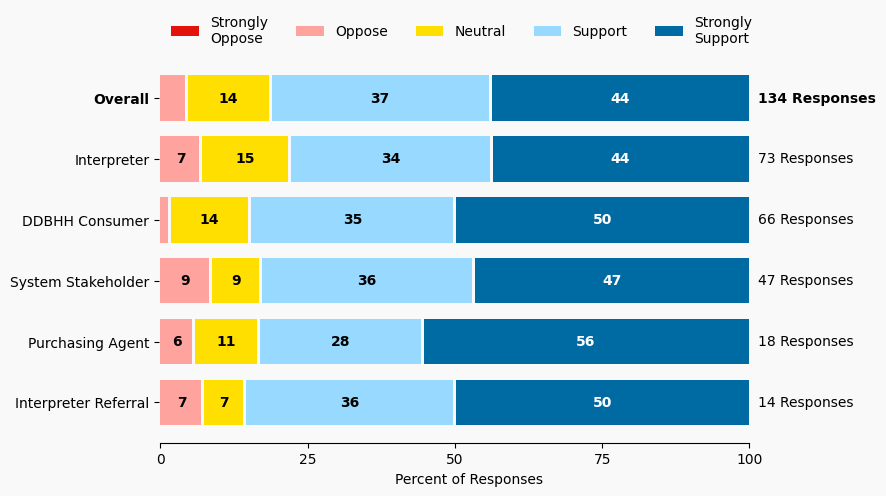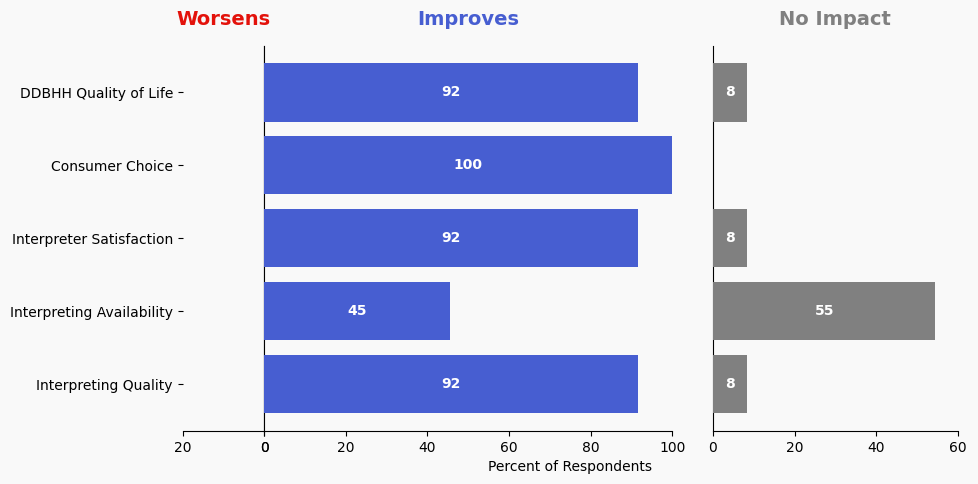27 Establish Grievance Process for Quality Control – Restorative and Timely Process
Issue: When something goes poorly in an interpreting setting, there are multiple considerations and perspectives. Sometimes there is gross negligence or incompetence on the part of the interpreter, and someone is grievously harmed. However, many concerns about interpreter performance could be resolved and harm repaired without legal or exhaustive and sometime ineffective processes. Constructive solutions rather than harsh or destructive penalties would not only be more humane but could also build the understanding and skill of working interpreters. A restorative approach would seek to make right whatever harm has been done and repair and strengthen relationships.
Proposed Solution: A coalition, led by the Commission, would institute a Restorative Grievance Process. The process would be DDBHH-centric, with education and restorative principles at the heart of the process. A quality specialist would be the primary interface for receiving the complaint, engaging the complait to understand the nature of the concern and moving the complaint forward if the complaint is one that is actionable. Complaints would receive an initial response within 48 hours. Valid complaints would be reviewed by a panel of DDBHH people and interpreters. Majority of valid complaints are likely to result in restorative and constructive solutions for the interpreter to improve on their professional practice. Measurable goals and outcomes would be included in regular and public reporting. Primary aims are to improve on interpreters’ professional practice and retain more skilled interpreters in the field, while also expanding DDBHH consumers’ understanding of what constitutes a violation of professional practice.
Expected outcome: DDBHH consumers would have a venue for timely complaint resolution. Interpreters would have greater ability to 1) improve upon their practice and 2) have misunderstandings resolved through a restorative process.
Who is impacted: Consumers, interpreters
Timeline: 6 months

Summary of Support Image Description
The stacked bar charts show how respondents rated their level of support and the total number of responses. The percentage for the five support levels is shown from left to right: Strongly Oppose (Dark Red), Oppose (Light Red), Neutral (Yellow), Support (Light Blue), and Strongly Support (Dark Blue).
Respondents may identify with multiple subgroups. The overall level of support is:
Overall
Strongly Oppose: 0%
Oppose: 4%
Neutral: 14%
Support: 37%
Strongly Support: 44%
Click to see the detailed image description for each subgroup.
Interpreter
Strongly Oppose: 0%
Oppose: 7%
Neutral: 15%
Support: 34%
Strongly Support: 44%
Purchasing Agent
Strongly Oppose: 0%
Oppose: 6%
Neutral: 11%
Support: 28%
Strongly Support: 56%
DDBHH Consumer
Strongly Oppose: 0%
Oppose: 2%
Neutral: 14%
Support: 35%
Strongly Support: 50%
Interpreter Referral
Strongly Oppose: 0%
Oppose: 7%
Neutral: 7%
Support: 36%
Strongly Support: 50%
System Stakeholder
Strongly Oppose: 0%
Oppose: 9%
Neutral: 9%
Support: 36%
Strongly Support: 47%
Overview of Respondents Opting for In-Depth Solution Analysis
After indicating their support level, 8% of the 134 respondents opted in to further assess whether the solution would worsen or improve on five metrics. Of the opt-in reviewers (11 respondents), 63% supported the solution, 27% were neutral on the solution, and 9% opposed the solution.
The remaining 123 respondents did not opt in to further assess the solution. Of these people, 82% support the solution, 13% were neutral on the solution, and 4% opposed the solution.
Reviewer Evaluation of Solution Effectiveness

Solution Effectiveness Image Description
The stacked bar charts show how respondents assessed the effectiveness of this solution based on five metrics. For each metric, the percentage of respondents is shown from left to right: Worsens (Red), Improves (Blue), No Impact (Gray).
DDBHH Quality of Life
Makes It Worse 0%
Makes It Better 91%
No Impact 8%
Interpreter Satisfaction
Makes It Worse 0%
Makes It Better 91%
No Impact 8%
Consumer Choice
Makes It Worse 0%
Makes It Better 100%
No Impact 0%
Interpreting Availability
Makes It Worse 0%
Makes It Better 45%
No Impact 54%
Interpreting Quality
Makes It Worse 0%
Makes It Better 91%
No Impact 8%
Reviewer Feedback and Insights
Interpreter
Comments from Interpreters suggest that the grievance process should be carefully designed to avoid unintended consequences for the interpreting community. One comment expresses concern around the potential for grievances to be used as punitive measures rather than constructive feedback.
Deaf, DeafBlind, Hard of Hearing
Comments from DDBHH Consumers express support for a clear grievance process, emphasizing the need for transparency and accessibility. One comment emphasizes the need to make the process easy to navigate and ensuring timely resolution of complaints. One comment highlights the need to ensure that grievances are handled fairly for both interpreters and consumers.
System Stakeholder
Comments from System stakeholders suggest that the grievance process could help improve the quality of interpreting services if implemented thoughtfully. One comment suggests incorporating a neutral third party to review complaints and ensuring that the process is fair to all parties involved.
PREVIOUS SOLUTION
26 Mentor Programs Focus on CDIs Mentoring Hearing Interpreters
Issue: Hearing interpreters report needing more mentoring to advance their skills. Often ASL fluency is a challenge for newer interpreters.
NEXT SOLUTION
28 Review Model, Policies and Practices of Interpreter Referral Companies
Issue: Consumers and interpreters are not always clear about how interpreter referral companies operate
Leave a Reply